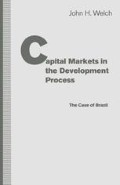Abstract
Brazil has actively pursued and achieved significant financial development since 1964. Tables I.1–I.3 confirm this proposition in a general way, showing that the ratio of financial institution assets to GNP rose from 0.53 in 1956 to 1.11 in 1976. Further, total non-monetary assets as a proportion of GDP increased from 0.2% in 1961 to 25% in 1984. Not only has the quantity of financial assets grown but so has the quality, as should become evident in this study.
Access this chapter
Tax calculation will be finalised at checkout
Purchases are for personal use only
Preview
Unable to display preview. Download preview PDF.
Notes
See Carlos A. P. Braga (1985): A Economia Brasileira na Segunda Metade dos Anos 80, Working Paper No. 18, University of São Paulo,among others.
Author information
Authors and Affiliations
Copyright information
© 1993 John H. Welch
About this chapter
Cite this chapter
Welch, J.H. (1993). Introduction. In: Capital Markets in the Development Process. Palgrave Macmillan, London. https://doi.org/10.1007/978-1-349-11211-1_1
Download citation
DOI: https://doi.org/10.1007/978-1-349-11211-1_1
Publisher Name: Palgrave Macmillan, London
Print ISBN: 978-1-349-11213-5
Online ISBN: 978-1-349-11211-1
eBook Packages: Palgrave Economics & Finance CollectionEconomics and Finance (R0)

